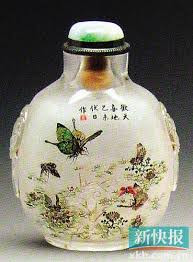In Western
studies, glass products of the Chinese Qing era (1644-1911) from multilayer
glass appear under the name "cameo-carved", that is, products
decorated with carvings similar to the decor of cameos (antique and later
Western carved stones imitating them). In a two-layer glass, combinations of
milky white and red are used; pink and green or blue; white and blue; red and
orange; yellow and green colors; in a three-layer - a combination of pink,
yellow and green fawn is often used. In most cases, lighter glass is used as a
background.
Art glass of the
Qian-Lung period (1711-1799) is the fused, blown in a furnace and molded
vessels, which, regardless of the thickness of the walls, appear to be
monolithic. Their legs are usually tightly connected to the body of the vessel,
acting as part of a single shape. On products imitating ancient bronze (for
example, incense burners in the form of tripods), stylized zoomorphic-geometric
images drawn from the same source vary (often a mask). Monochromes use
calligraphy (for example, lines from poems authored by the emperor Qian-Lung
(1711-1799)).
The heyday of
the court workshops ceased to the beginning of the era of Jia-ching
(1796-1820), and already in the XIX century, most of the best quality
decorative glass products were created in private Beijing workshops. This also
applies to the production of snuffboxes biyanhu, which constituted a special
group of applied things, the appearance of which in China was due to European
influence. Immediately becoming collectibles, Qing snuffboxes are stored today
in many museums (including Beijing Gugun, London Victoria and Albert Museum,
St. Petersburg State Hermitage Museum) and in collections of private collectors
around the world.
If you liked this story, please share it with whoever you like. In the same way we are uploading to the blog valuable information about glass or mirror applications. So we invite you to read another interesting article:




